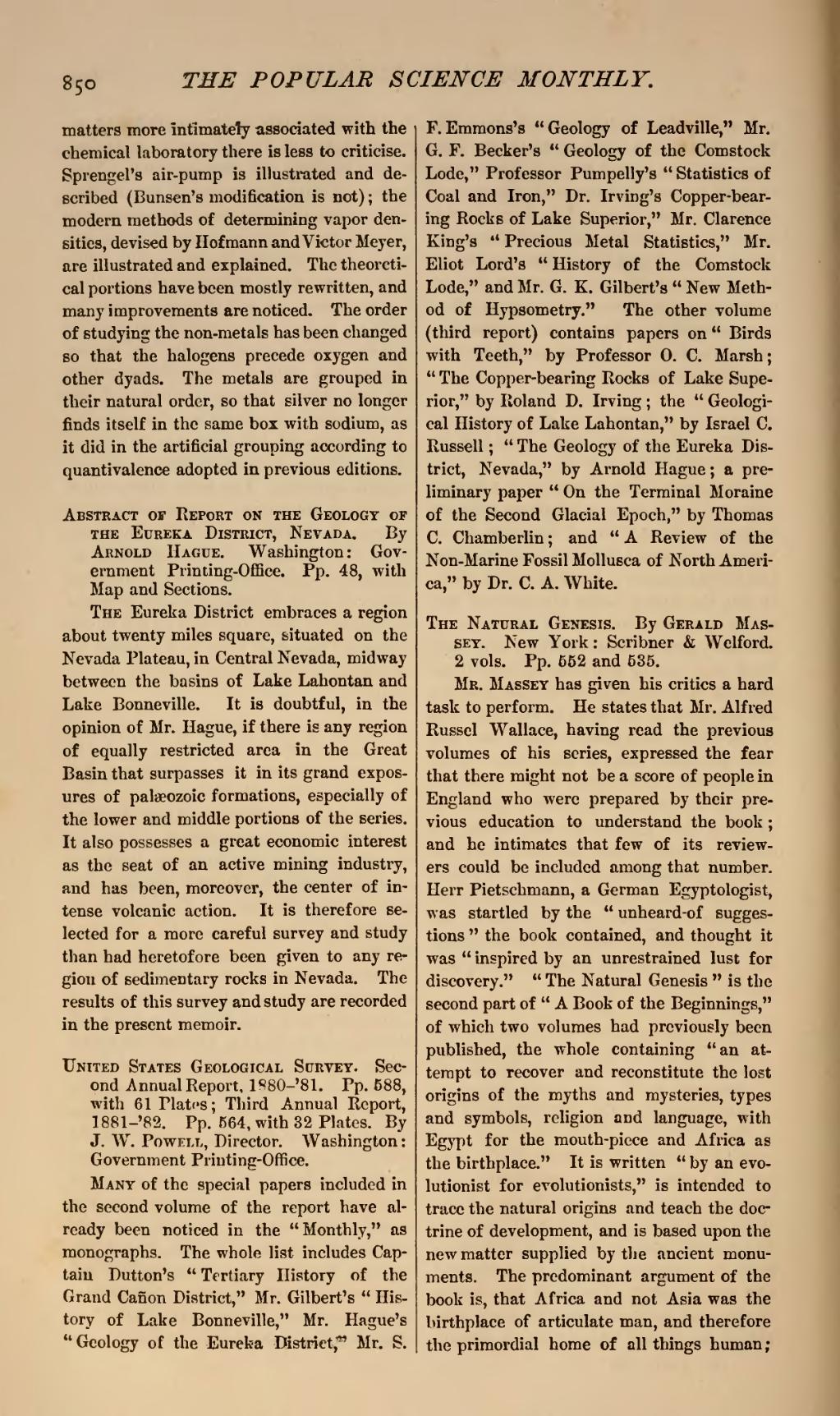matters more intimately associated with the chemical laboratory there is less to criticise. Sprengel's air-pump is illustrated and described (Bunsen's modification is not); the modern methods of determining vapor densities, devised by Hofmann and Victor Meyer, are illustrated and explained. The theoretical portions have been mostly rewritten, and many improvements are noticed. The order of studying the non-metals has been changed so that the halogens precede oxygen and other dyads. The metals are grouped in their natural order, so that silver no longer finds itself in the same box with sodium, as it did in the artificial grouping according to quantivalence adopted in previous editions.
Abstract of Report on the Geology of the Eureka District, Nevada. By Arnold Hague. Washington: Government Printing-Office. Pp. 48, with Map and Sections.
The Eureka District embraces a region about twenty miles square, situated on the Nevada Plateau, in Central Nevada, midway between the basins of Lake Lahontan and Lake Bonneville. It is doubtful, in the opinion of Mr. Hague, if there is any region of equally restricted area in the Great Basin that surpasses it in its grand exposures of palæozoic formations, especially of the lower and middle portions of the series. It also possesses a great economic interest as the seat of an active mining industry, and has been, moreover, the center of intense volcanic action. It is therefore selected for a more careful survey and study than had heretofore been given to any region of sedimentary rocks in Nevada. The results of this survey and study are recorded in the present memoir.
United States Geological Survey. Second Annual Report, 1880-'81. Pp. 588, with 61 Plates; Third Annual Report, 1881-'82. Pp. 564, with 32 Plates. By J. W. Powell, Director. Washington: Government Printing-Office.
Many of the special papers included in the second volume of the report have already been noticed in the "Monthly," as monographs. The whole list includes Captain Dutton's "Tertiary history of the Grand Canon District," Mr. Gilbert's "History of Lake Bonneville," Mr. Hague's "Geology of the Eureka District," Mr. S. F. Emmons's "Geology of Leadville," Mr. G. F. Becker's "Geology of the Comstock Lode," Professor Pumpelly's "Statistics of Coal and Iron," Dr. Irving's Copper-bearing Rocks of Lake Superior," Mr. Clarence King's "Precious Metal Statistics," Mr. Eliot Lord's "History of the Comstock Lode," and Mr. G. K. Gilbert's "New Method of Hypsometry." The other volume (third report) contains papers on "Birds with Teeth," by Professor O. C. Marsh; "The Copper-bearing Rocks of Lake Superior," by Roland D. Irving; the "Geological History of Lake Lahontan," by Israel C. Russell; "The Geology of the Eureka District, Nevada," by Arnold Hague; a preliminary paper "On the Terminal Moraine of the Second Glacial Epoch," by Thomas C. Chamberlin; and "A Review of the Non-Marine Fossil Mollusca of North America," by Dr. C. A. White.
The Natural Genesis. By Gerald Massey. New York: Scribner & Welford. 2 vols. Pp. 552 and 535.
Mr. Massey has given his critics a hard task to perform. He states that Mr. Alfred Russel Wallace, having read the previous volumes of his series, expressed the fear that there might not be a score of people in England who were prepared by their previous education to understand the book; and he intimates that few of its reviewers could be included among that number. Herr Pietschmann, a German Egyptologist, was startled by the "unheard-of suggestions" the book contained, and thought it was "inspired by an unrestrained lust for discovery." "The Natural Genesis" is the second part of "A Book of the Beginnings," of which two volumes had previously been published, the whole containing "an attempt to recover and reconstitute the lost origins of the myths and mysteries, types and symbols, religion and language, with Egypt for the mouth-piece and Africa as the birthplace." It is written "by an evolutionist for evolutionists," is intended to trace the natural origins and teach the doctrine of development, and is based upon the new matter supplied by the ancient monuments. The predominant argument of the book is, that Africa and not Asia was the birthplace of articulate man, and therefore the primordial home of all things human;

